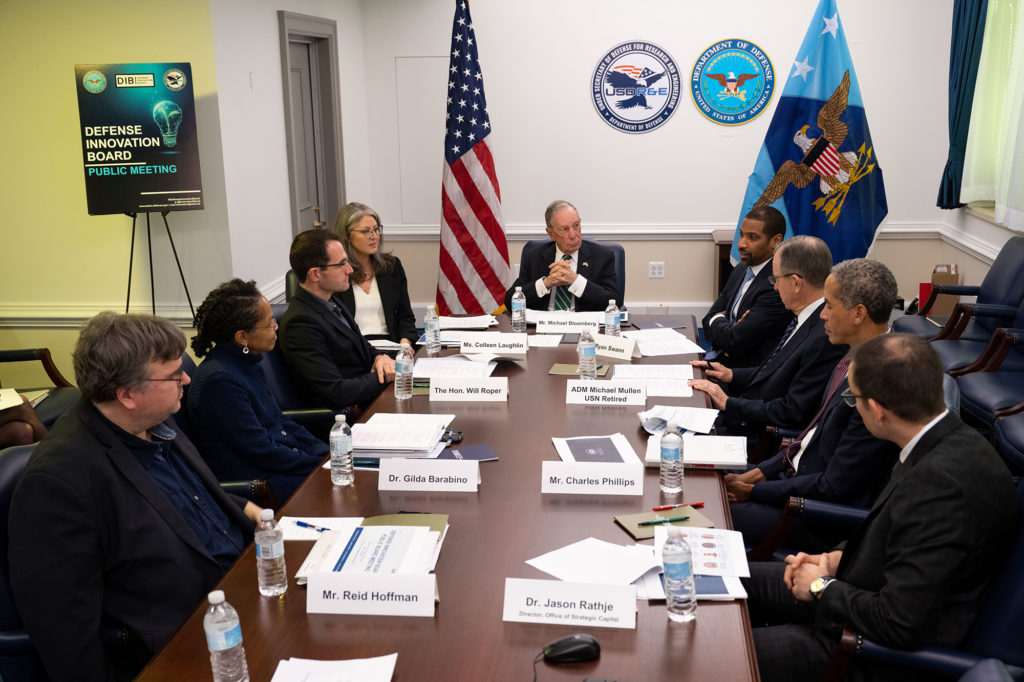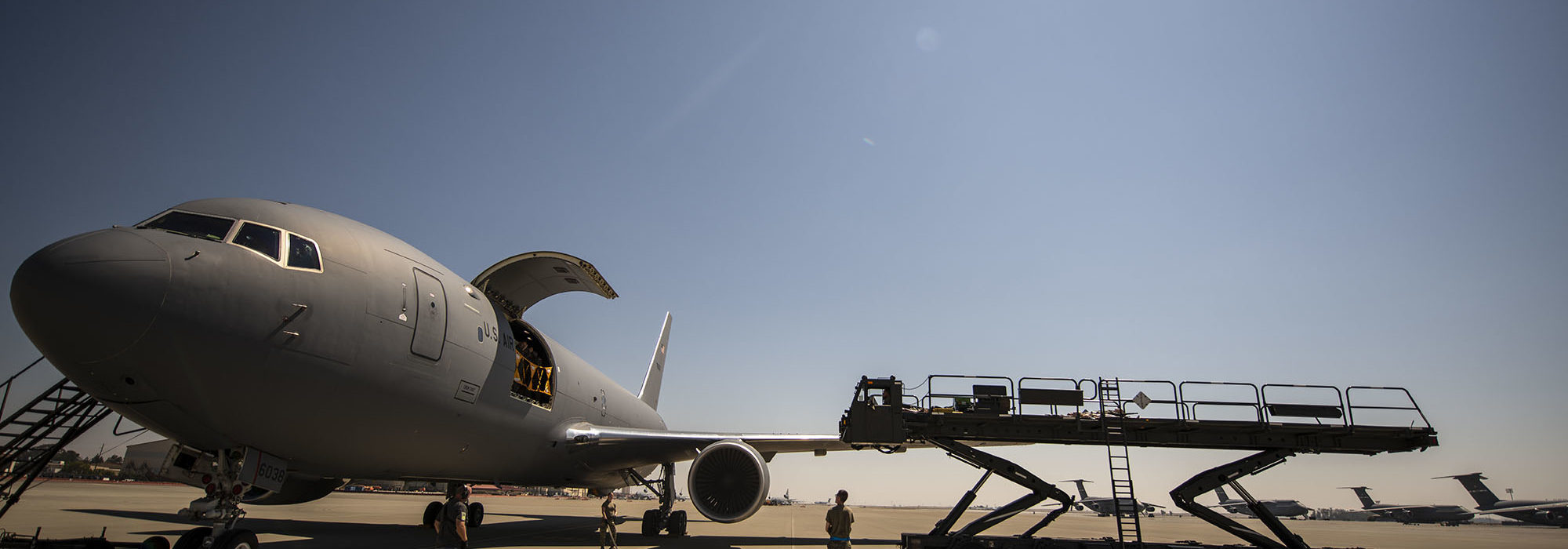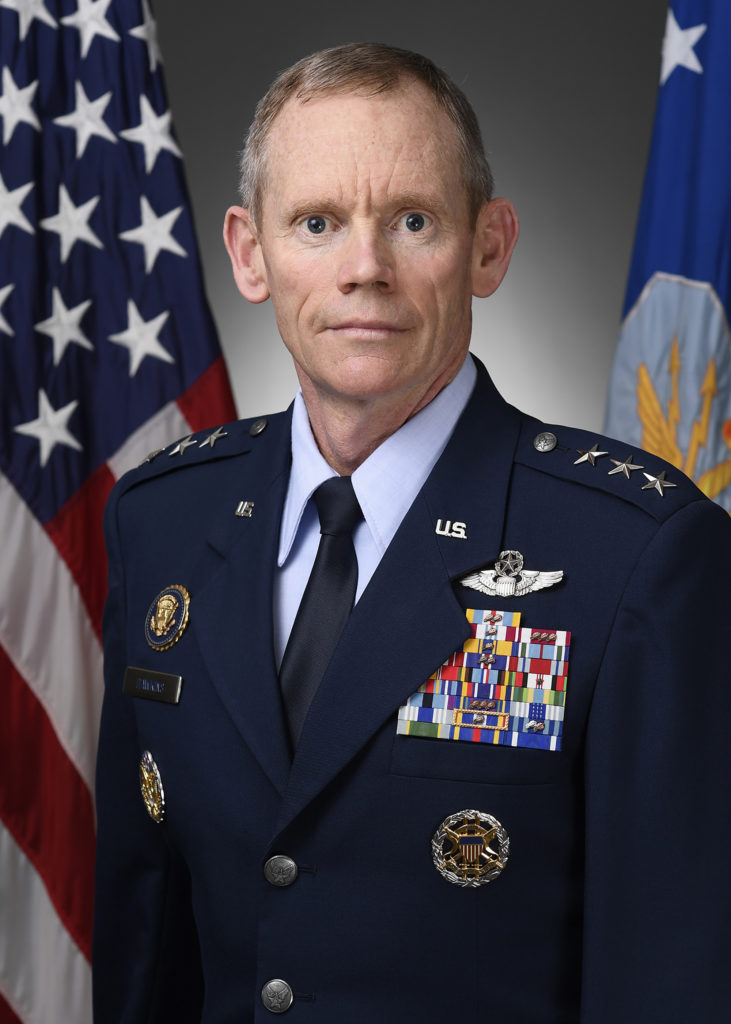New KC-46 Tankers Coming— but New Deficiency Revealed
By Greg Hadley
T
he Air Force awarded Boeing a $2.2 billion contract for 15 KC-46 tankers, the ninth lot of the aerial refuelers, just days after the Air Force Life Cycle Management Center acknowledged a previously undisclosed deficiency with the aircraft.
The latest purchase order is roughly the same as the Lot 8 order from Aug. 31, 2022. The number of aircraft is the same, but the cost slightly increased. Work on the 15 aircraft is expected to be completed in 2026.
The KC-46 Pegasus has suffered a stream of deficiencies since its introduction, including ongoing issues with its over-stiff boom and the remote vision system for boom operators. But the latest deficiency has nothing to do with aerial refueling; instead, the ding is for insufficient documentation for loading cargo on the jets.
The Defense Department’s Office of the Director, Operational Test and Evaluation, disclosed the latest problem in its annual report, which noted that the Air Force Operational Test and Evaluation Center (AFOTEC) had determined that several “individual cargo-related deficiencies merited generation of a Category I emergency deficiency report against overall KC-46A cargo operations capability.”
An Air Force Life Cycle Management Center spokesperson, responding to questions from Air & Space Forces Magazine, acknowledged the deficiency, but said it had been downgraded to a Category II deficiency in November 2022. The command did not indicate if that was based on progress toward its resolution or simply a judgment call.
The problems are related to five issues:
- Complex, unorganized cargo loading guidance;
- Nonstandard cargo limitations, causing aircrew confusion and requirement of onboard cargo inspections;
- Restrictions regarding the cargo barrier net can prohibit loading sufficient, or any, cargo if the forward-most cargo does not meet requirements;
- Problems with the Automated Performance Tool software used to calculate aircraft weight and balance can increase loadmaster workload and require complex manual calculations, introducing potential human error; and
- Aerial port operational restrictions caused by inadequate technical guidance increase workload for loading personnel and loading times, driving KC-46A incompatibilities within the Defense Transportation System.
The Air Force defines Category I deficiencies as those which prevent “the accomplishment of an essential capability or critically restricts [operational safety, suitability, and effectiveness],” with no known workaround. By contrast, a Category II deficiency is one “which adversely affects an essential capability or negatively impacts operational safety, suitability, or effectiveness,” but can be overcome by “significant compensation or acceptable workaround.”
According to Air Force policy, a program manager can downgrade a submitted deficiency report (DR) provided there is agreement with the test director of the operational test agency, in this case AFOTEC. Asked if AFLCMC followed this procedure and coordinated with AFOTEC, neither agency responded.
The AFLCMC spokesman did say that “the estimated completion date for the solutions to close the DR is [the third quarter of fiscal year 2023],” putting it between April and June. No further details were offered. Boeing also did not immediately reply to a request for comment.
The Air Force has officially recorded nine Category I deficiencies with the KC-46, most of which officially remain open. Boeing executives told reporters in December that some of those open deficiencies are formalities at this stage, the result of infrequent meetings of the KC-46 deficiency board.
The issues that led to this latest deficiency report are unrelated to the cargo lock problem that barred the KC-46 from carrying cargo or passengers for three months in 2019. That problem, which was solved and closed out in December 2019, required changes to the cargo pallet locks, which until then, had sometimes come unlocked in flight.
Boeing and the Air Force have touted the KC-46’s cargo capabilities in comparison to the legacy KC-135 tanker; they have said the aircraft can carry up to 18 pallets, 114 passengers in contingency situations, or more than 50 patients for an aeromedical evacuation.
The most prominent Category I deficiencies, however, remain months, if not years, away from being resolved, most prominently the troubled Remote Vision System, an array of cameras and screens the boom operator uses to connect and refuel other aircraft. The current setup can result in “whiteouts” or “blackouts” for the boom operator in certain lighting conditions, heightening the risk of the boom accidentally scraping a receiver aircraft. That is particularly troublesome for aircraft with stealth coatings like the F-35 fighter or B-2 bomber.
Another key deficiency that remains unresolved is a “stiff” boom—some receiver aircraft, particularly the A-10, cannot maintain the thrust against the boom necessary to keep it engaged. As a result, the KC-46 is still not cleared to refuel A-10s.
The rest of the Category I deficiencies are classified as “product quality,” and primarily related to cracks or leaks. Boeing is working on the issues.
Boeing has delivered more than 60 KC-46s to date, with a planned buy of 179 over the life of the program. The Air Force has also considered increasing that number rather than acquiring a so-called KC-Y in the future.
What Concerns These Air Force Generals Most about Nuclear Modernization Right Now
By Christopher Prawdzik
Manpower, material, and funding remain the foundation—and a key concern—for the Air Force’s top-to-bottom nuclear modernization effort, a pair of top generals said Jan. 24.
That modernization effort covers everything from personnel to weapons systems to entire facilities, and the service must execute this massive undertaking without losing the slightest bit of operational superiority in a world where nuclear threats have considerably increased, Lt. Gen. James C. Dawkins Jr. and Maj. Gen. Michael J. Lutton said during an Aerospace Nation event hosted by the Mitchell Institute for Aerospace Studies.
A reminder of those increased threats came shortly before the event began, when the Bulletin of Atomic Scientists moved its infamous “Doomsday Clock” to just 90 seconds before midnight, the closest it has ever been, driven primarily by Russia’s invasion of Ukraine and subsequent nuclear saber-rattling.
At the same time, the Air Force is in the thick of its nuclear modernization program—according to Dawkins, deputy chief of staff for strategic deterrence and nuclear integration, the “bow wave” of new requirements and fielding of new systems discussed a decade or more ago is now here. With the enormous number of systems and improvements on the horizon, immense challenges follow.
“Believe it or not, what I worry about most, more than anything right now—more than technology—is concrete and rebar, reinforcement steel that goes in the concrete to build the 650 construction projects that we have, not just in the missile fields but across the nuclear enterprise,” Dawkins said. “It has to be built in the next 12 years in 13 states.”
He noted a number of systems and equipment that will be fielded in the coming years, including the recently rolled-out B-21, the air-launched B61-12 tactical bomb, the MH-139 Grey Wolf helicopter for missile site security, and a modernized nuclear command, control, and communications network. But that’s only part of the picture.
“Anytime you transition and do everything at the same time, you’ve got to really be careful about how you orchestrate that,” Dawkins said. “That is going to require a lot of work by our Global Strike Command to ensure that they, again, do that just right.”
The personnel component to these efforts is also crucial, and Dawkins particularly emphasized the need for experts in critical areas—such as electricians, pipe fitters, and welders—to keep the multitude of projects on schedule.
Lutton, commander of the 20th Air Force, discussed the human capital component of the process and how talent management shapes and is shaped by emerging systems and technology. He focused on the integration of Grey Wolf, along with the ground-based Sentinel ICBM system that’s replacing the Minuteman III.
“Some of the similar questions about talent management, talent retention, talent placement, when you’re building a new weapon system, are agnostic of the weapon system, whether it’s an aircraft or a missile system,” Lutton said. “So Grey Wolf right now is teaching us some lessons that will definitely export to Sentinel.”
Lutton said Sentinel has prompted some organizational changes, with the flight-test squadron evolving into a test and evaluation group. This will include a flight-test squadron, test support squadron, and a maintenance test squadron. Overall, these developments have expanded opportunities for Airmen across the board, particularly when it comes to the country’s ICBM defense.
“Historically, and by historically I can only talk about the time that I’ve served, we’ve never really been ‘Total Force’ in the ICBM business,” Lutton added, noting that the first Reservist weapons officer graduated from the U.S. Air Force Weapons School in December. “We are looking to build so much more Total Force opportunity in the ICBM business, and that does two new things for us: One, it gives us incredible depth of expertise, and two, it allows our Airmen to have options.”
In addition, Lutton noted the service has increased communication about “why” Airmen are doing what they’re doing, looking closely at world events and diplomacy to form a better understanding of their role.
“There’s a component to it where we have to ensure that we’re still very active with counterproliferation,” he said. “We still have to ensure that we’re very active with nuclear nonproliferation, and then we have obviously a very healthy treaty system that is transparent and compliant.”
Dawkins said stable funding remains essential, and he’s pleased with the bipartisan support the mission has had for many years—even with the scrutiny the nuclear enterprise often receives. Still, raw materials, personnel, and tight timelines remain at the forefront.
“We deferred programs back to the early 2000s, and then we had sequestration, and so we don’t have a lot of margin to produce these,” he said, adding that while producing new systems, the current ones must endure. “The ICBMs that General Lutton commands and is in charge of out there in missile fields have to be as good on their last day as they were on their first day, and that continues to get more challenging.”
Hinote Urges DIB to Find Incentives for Faster Technology Development

By John A. Tirpak
As the Defense Department engages commercial entities to speed innovation, cultural and structural differences between government and the private sector continue to be the biggest hurdle to rapidly deploying new technology, the head of Air Force Futures told the influential Defense Innovation Board (DIB) at a recent meeting.
“It’s not an access to innovation problem that we’re dealing with, it’s an innovation adoption problem,” said Air Force Lt. Gen. S. Clinton Hinote, deputy chief of staff for strategy, integration, and requirements, noting a number of barriers he’s experienced in recent years. “I’ve witnessed each of these [barriers] stifle innovation on behalf of the bureaucracy and at the expense of tomorrow’s warfighter.”
Hinote made his remarks at the end of a two-day meeting of the new Defense Innovation Board. Chaired by Michael Bloomberg, the nine-member board includes academics, technology professionals, and other experts who advise DOD on emerging technology and innovation and how to promote military technological dominance. Among its members are former Assistant Secretary of the Air Force Will Roper and retired Adm. Michael Mullen, former Chairman of the Joint Chiefs of Staff.
Passionate but positive, Hinote urged the board to identify incentives throughout the acquisition world that can speed technology development in a culture rife with bureaucratic roadblocks.
He said he’s witnessed leaders from three different administrations come in with a sense of urgency, only for that dynamic to not permeate through the bureaucracy. “Having the lack of sense of urgency in the middle is deadly, and that’s what it has been for us,” Hinote said.
One particular area Hinote focused on was risk timelines, noting that DOD’s actions are based on near-term risks, in contrast to its stated focus. Hinote also said there is a strong tendency to focus on “old ways” instead of new ones.
“There are a lot of soft vetoes in our department … and at any one point, there are so many different people, offices, interests that can block an action,” Hinote said. “They can’t start an action; they can’t initiate or get an action through, but they can block, and that’s a fact of life in this department that makes it very difficult to keep going.”
He added that there’s also a strong “not-invented-here culture,” where there can be competition between internal and external science and technology sectors. And while some competition between sectors can be good, Hinote added, it can be challenging when the timelines of a company differ from the government’s budget timelines.
It’s a particular issue with small startups whose fast-paced innovation might be perfect for DOD, but the startup must fund itself for multiple years until the budget process catches up with them. On top of that budget process, he added, is a lack of trust between the executive and legislative branches, particularly when looking at finding flexibility on how money is spent.
“At some point, we’re going to have to explore what types of transparency we need to get our congressional stakeholders semi-comfortable with the type of flexibility that we know we have to get to,” Hinote said. “And I think that involves a flexibility in intellectual property that we have not seen yet.”
In challenging the board to map out incentives, he emphasized the need to tap more into intellectual property and use it to scale.
For example, Hinote suggested that in critical times of need, if U.S. forces have good technology and an ally has good manufacturing capability, “it is in the national interest to release the intellectual property, give it to the partner and let them build the weapons, because at the moment, we are not able to build enough weapons fast enough,” he said.
Ultimately, Hinote said, the conversation must change, because oftentimes there’s little incentive to push technology boundaries, increase the speed of a bureaucratic process, or take risks.
“I don’t believe this is impossible; I don’t believe that people want to watch innovation flounder in our department,” he said. “But the incentives are structured in a way that makes it darn impossible, and until we call it out, I just don’t see how it gets better.”
In another brief to the board, Jason Rathje, director of the Office of Strategic Capital (OSC) and co-founder and former director of AFWERX’s AFVentures division, insisted the government must do more to increase capital access for innovators.
With so many American companies investing and developing capabilities in science and technology, boosted by cooperation with academia, there has been world-class advancement in critical areas, Rathje said. But there needs to be a next step—to provide opportunities for entrepreneurs to have their technologies support national security goals.
Rathje added that OSC is looking at two new strategies to promote private investment as a national security tool: syndication and leverage.
“Syndication is a strategy that simply partners with private capital providers to co-invest in new technology efforts to help scale the business as we help scale the technology,” he said. “What leverage does is it lowers the cost of capital; private investors can make patient capital investments that are required, at the sizes that they’re required to invest, in deep technology companies.”
Rathje also celebrated the OSC’s partnership with the Small Business Administration and working with the Small Business Investment Company program. SBIC provides investment opportunities to technology companies in their early stages by leveraging the Federal Credit Program.
“The way these investment funds work is that we can license new limited partnerships that are vertically focused on deep technology areas,” he said. “We can provide two dollars of leverage, two dollars of debt, for every dollar of private capital that is raised.”
The SBIC initiative began in December, and Rathje said they hope to begin receiving applications for the initiative by mid-year. In addition, OCS will soon publish its inaugural investment strategy, which will review critical technology sectors and provide assessments regarding capital availability.

